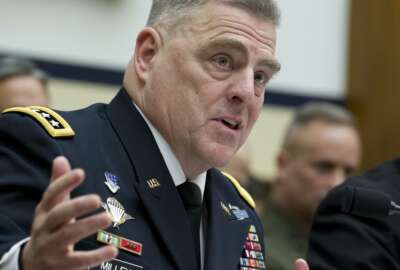The Defense acquisition workforce may see a new era in training, recruiting and retainment as the Pentagon and military services change the way they view the value of their employees.
Both the Army and the Defense Department are making changes in how they evaluate and prioritize the experience and education of the acquisition workforce.
The Army recently released a directive focused on acquisition talent management.
“We want our people to have an appropriate set of experiences,” acting Army Secretary Ryan McCarthy said of the directive during a speech this week at an Association of the United States Army conference in Washington. “We want our program managers and officers to have fellowships with industry, masters degrees within certain disciplines. It’s also about the tenures for people in program management. We’re looking at tours of three-to-four years, so more continuity and the right set of experiences so that they have a broader perspective than the ones we’ve had previously.”
Army Principal Deputy Assistant Secretary for Acquisition, Logistics and Technology Steffanie Easter said Oct. 11 that another part of the directive makes sure acquisition professionals have the training and education they need on day one of their job.
Part of that is putting more emphasis on acquisition professionals having operational experience. Easter said the Army is less interested in acquisition employees who were pruned for that position.
The directive mandates more standardized training for people who write contract requirements to reflect the training of program managers.
“We started recently working with [Defense Acquisition University (DAU)] to get a requirement writing officers class,” Easter said. “We need more teaching people to lead through the acquisition process. That way we will be a little less process dependent and give us a lot more flexibility.”
The directive comes as the Army undertakes its biggest reorganization of its acquisition bureaucracy since the Vietnam era.
In creating a new “modernization command,” officials say they want soldiers to be involved in the acquisition process from beginning to end, the theory being that previous efforts have asked for feedback from end users far too late in the acquisition process, prompting changes that are difficult and expensive to make once a system has progressed too far into its development lifecycle.
Defense Department
DoD is undertaking a massive acquisition reorganization too as it begins splitting its acquisition office into a research and development side and a policy and day-to-day acquisition side.
Defense Undersecretary for Acquisition, Technology and Logistics Ellen Lord made a goal of cutting contract delivery time by 50 percent as part of that reorganization. Lord wants to do that by streamlining the acquisition process and making the workforce more aware of existing authorities.
In order to do that, the acquisition workforce will see some changes as well.
“We’re looking very, very hard at DAU and what we are doing there; how we are training people,” Lord said. “We do not do a lot of training on service contracts.”
Lord said she didn’t think DAU’s training was contemporary.
Service contracts have been a point of frustration for both DoD and Congress.
Service contracts make up about $150 billion in DoD spending per year, but the Pentagon has had trouble overseeing those contracts.
A House Armed Services Committee staffer said DoD has very little information on what it’s contracting and what DoD is getting for it.
The staffer said services requirements are evaluated late in the budget process and often without the right strategic focus.
“DoD doesn’t ask could we contract at a lesser amount or not contract at all,” the staffer said.
The Government Accountability Office put DoD service contracting on its high-risk list for its challenges with acquisition workforce, contracting techniques and contract support.
DoD overhauled some of its service contract processes in early 2016. The policy centralized the contracting by creating expert positions that preside over each service sector.
Lord said she wants to look at the interfaces to acquisition office as well.
“We cannot simplify and speed up the acquisition process if we are not aligning [interfaces] very, very closely with” the Defense Contract Management Agency and the Defense Contract Audit Agency and the auditing processes, Lord said. “We have about 400,000 contracts right now [at DCAA] that we are trying to close out, which is just amazing, looking at incurred costs. We just have to get better at this.”
Congress has not turned a blind eye to DCAA’s plight. The House version of the 2018 defense authorization bill would raise the cost threshold for contracts DCAA will have to audit. The goal is by 2020, 25 percent of incurred cost contracts will be done by a private auditor.
That may create some savings in headquarters costs. DCAA has had to add to its staff to keep up with the demand.
DCAA was planning on hiring 100 people a month and began doing that in the first quarter of fiscal 2017, until the hiring freeze was implemented by President Donald Trump. DCAA Director Anita Bales said the agency would need 500 more employees or about 10 percent of its current workforce to do its audit portfolio.
Copyright
© 2024 Federal News Network. All rights reserved. This website is not intended for users located within the European Economic Area.

